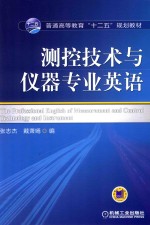图书介绍
测控技术与仪器专业英语PDF|Epub|txt|kindle电子书版本网盘下载

- 张志杰,戴萧嫣编 著
- 出版社: 北京:机械工业出版社
- ISBN:9787111480334
- 出版时间:2014
- 标注页数:192页
- 文件大小:100MB
- 文件页数:203页
- 主题词:测量系统-控制系统-英语-高等学校-教材;电子测量设备-英语-高等学校-教材
PDF下载
下载说明
测控技术与仪器专业英语PDF格式电子书版下载
下载的文件为RAR压缩包。需要使用解压软件进行解压得到PDF格式图书。建议使用BT下载工具Free Download Manager进行下载,简称FDM(免费,没有广告,支持多平台)。本站资源全部打包为BT种子。所以需要使用专业的BT下载软件进行下载。如BitComet qBittorrent uTorrent等BT下载工具。迅雷目前由于本站不是热门资源。不推荐使用!后期资源热门了。安装了迅雷也可以迅雷进行下载!
(文件页数 要大于 标注页数,上中下等多册电子书除外)
注意:本站所有压缩包均有解压码: 点击下载压缩包解压工具
图书目录
Chapter 1 Introduction1
1.1 Why Do We Care about Measurement?1
1.1.1 Why Measure Anything?1
1.1.2 The History of Measurement2
1.2 Basic Instrumentation2
1.2.1 Measurements Must Have a Reference3
1.2.2 Basic Principles4
1.3 Case Studies5
Words and Expressions12
Notes13
Exercises15
Chapter 2 Sensors:The First Stage in the Measurement Chain16
2.1 Sensors versus Transducers16
2.2 First Steps:Understanding the Measurand16
2.3 Sensors as Black Boxes—For Now17
2.4 There's Plenty More to Consider18
2.5 Definitions20
2.6 Examples of Temperature Applications21
Words and Expressions25
Notes25
Exercises26
Chapter 3 Sensors and Signal Conditioning27
3.1 Transfer Function27
3.1.1 Zero-Order Systems27
3.1.2 First-Order Systems28
3.1.3 Second-Order Systems28
3.2 The Electronics of Signal Conditioning29
3.2.1 Excitation30
3.2.2 Input Matching31
3.2.3 Translation31
3.2.4 Linearization31
3.2.5 Noise31
3.2.6 Protection32
3.3 Example Temperature Applications32
Words and Expressions33
Notes34
Exercises35
Chapter 4 Analog-to-digital Conversion37
4.1 Conversion Fundamentals37
4.1.1 Signal Conditioning37
4.1.2 Sampling37
4.1.3 Aliasing38
4.1.4 Antialiasing Filter39
4.1.5 Hold That Sample40
4.1.6 Amplitude Quantization41
4.1.7 Signal-to-Noise Ratio41
4.1.8 Other Considerations42
4.2 Realities of Conversion43
4.2.1 Sample and Hold Circuitry43
4.2.2 Quantizer44
4.2.3 SNR Revisited45
4.3 Converter Architectures45
4.3.1 Flash and Pipeline45
4.3.2 Integrating46
4.3.3 Successive Approximation47
4.3.4 Oversampling48
4.4 Example Application:Bits versus Bandwidth49
Words and Expressions50
Notes51
Exercises52
Chapter 5 Measurement Uncertainty54
5.1 The Measurement Concept54
5.2 A Big Scientific and Technical Problem55
5.3 The Uncertainty Concept57
5.4 The GUM Approach to Uncertainty:Definitions and Methods for Its Determination58
5.4.1 Type A Evaluation59
5.4.2 Type B Evaluation59
5.4.3 Around Values Attributed to the Measurand Confidence Interval Evaluation59
5.4.4 Combined Standard Uncertainty60
5.5 The Role of the Standard and the Traceability and Compatibility Concepts62
5.6 Calibration62
Conclusions64
Words and Expressions64
Notes65
Exercises67
Chapter 6 Data Processing in Measurement Instrumentation68
6.1 Data Processing68
6.2 Advantages of Digital Data Processing69
6.3 Characteristics of Data Processing—Real Time and Correct69
6.4 Types of Data Processing70
6.4.1 Filters70
6.4.2 Finite Impulse Response Filters71
6.4.3 Infinite Impulse Response Filters71
6.4.4 Discrete Fourier Transform and Fast Fourier Transform72
6.4.5 More to Follow72
6.5 Types of Processors73
6.6 DSPs75
Summary77
Words and Expressions77
Notes78
Exercises79
Chapter 7 Control Output Devices—Actuators and Displays for Process Automation80
7.1 Direct Current Motors80
7.2 Induction Motors83
7.3 Solenoids85
7.4 Stepper Motors86
7.5 Micro Actuators87
7.6 Display and Recording Equipment89
7.6.1 Computer Display89
7.6.2 Data Loggers90
Conclusions91
Words and Expressions91
Notes92
Exercises93
Chapter 8 Control Theory94
8.1 An Introduction to Negative Feedback94
8.2 Negative Feedback—Some Classical Examples95
8.2.1 The Outrigger95
8.2.2 The Water Clock96
8.2.3 The Flyball Governor96
8.3 Why Should Someone Who Deals with Instrumentation and Measurement Want to Understand Control Theory?97
8.4 A Brief Introduction to the History of Classical Control Theory98
8.5 Negative Feedback—A First Mathematical Approach98
8.6 Negative Feedback,Hish Gains,and Disturbance Rejection100
8.7 Trouble in Paradise101
Words and Expressions102
Notes103
Exercises104
Chapter 9 Obtaining Pitch/Roll Measurements in an Extreme Environment105
9.1 Effects of Extreme Environment105
9.2 Choosing Components106
9.2.1 Crystals106
9.2.2 Orientation Sensors106
9.2.3 Batteries107
9.3 Mechanical Isolation108
9.3.1 Potting Encapsulation108
9.3.2 Internal and External Isolation109
9.4 Sensor Calibrations109
9.5 Thermal Behavior112
9.6 Signal Processing112
9.7 Achieved Accuracies113
9.8 Summary113
Words and Expressions113
Notes114
Exercises115
参考翻译117
第1章 引言117
1.1 为什么我们对测量如此关注?117
1.1.1 为什么任何东西都需要测量?117
1.1.2 测试的历史118
1.2 基本仪器118
1.2.1 测量必须有一个参照标准118
1.2.2 基本原则119
1.3 实例研究120
第2章 传感器:测量的首要环节127
2.1 传感器与转换器127
2.2 第一步:了解被测量127
2.3 目前看做黑箱的传感器128
2.4 需要考虑的更多问题128
2.5 定义130
2.6 温度应用实例130
第3章 传感器与信号调理134
3.1 传递函数134
3.1.1 零阶系统134
3.1.2 一阶系统135
3.1.3 二阶系统135
3.2 信号调理电子学135
3.2.1 激励137
3.2.2 输入匹配137
3.2.3 转换137
3.2.4 线性化137
3.2.5 噪声137
3.2.6 保护138
3.3 关于温度应用的例子138
第4章 模拟信号到数字信号的转换140
4.1 转换原理140
4.1.1 信号调理140
4.1.2 采样140
4.1.3 混叠142
4.1.4 抗混叠滤波器142
4.1.5 采样保持142
4.1.6 幅度量化143
4.1.7 信噪比144
4.1.8 其他注意事项144
4.2 转换的实现145
4.2.1 采样和保持电路145
4.2.2 量化145
4.2.3 信噪比146
4.3 转换器结构147
4.3.1 闪存型和流水线型147
4.3.2 积分型148
4.3.3 逐次逼近型149
4.3.4 过采样型150
4.4 应用实例:位数与带宽150
第5章 测量不确定度152
5.1 测量的概念152
5.2 科学和技术问题153
5.3 不确定度的概念154
5.4 GUM方法:定义和方法155
5.4.1 A类不确定度评价155
5.4.2 B类不确定度评价155
5.4.3 被测量置信区间评价的近似值155
5.4.4 标准不确定度的合成156
5.5 标准的作用、溯源性与兼容性概念157
5.6 校准158
结论159
第6章 测试仪器中的数据处理160
6.1 数据处理160
6.2 数字信号处理的优势160
6.3 数据处理的特点——实时、准确161
6.4 数据处理的类型161
6.4.1 滤波器162
6.4.2 有限长单位冲激响应滤波器162
6.4.3 无限长单位冲激响应滤波器163
6.4.4 离散傅里叶变换和快速傅里叶变换163
6.4.5 进一步介绍163
6.5 处理器类型164
6.6 数字信号处理器166
总结167
第7章 控制输出设备——过程自动化执行器和显示设备168
7.1 直流电动机168
7.2 感应电动机171
7.3 螺线管172
7.4 步进电动机173
7.5 微执行器174
7.6 显示和记录设备175
7.6.1 计算机显示设备175
7.6.2 数据记录仪176
结论177
第8章 控制理论178
8.1 负反馈简介178
8.2 负反馈——一些经典的例子179
8.2.1 船舷外支架179
8.2.2 滴漏179
8.2.3 飞球式调控器180
8.3 为什么许多从事仪器仪表和测试的人想要了解控制理论?180
8.4 经典控制理论的历史简介181
8.5 负反馈——第一个数学方法181
8.6 负反馈、高增益和抑制干扰183
8.7 天堂陷阱183
第9章 在极端环境中获取倾斜/滚动的测量结果185
9.1 极端环境的影响185
9.2 选择零件185
9.2.1 晶体185
9.2.2 方向传感器185
9.2.3 电池187
9.3 机械隔离187
9.3.1 灌封封装187
9.3.2 内部隔离与外部隔离188
9.4 传感器校准188
9.5 热性能190
9.6 信号处理190
9.7 达到的精度191
9.8 总结191
参考文献192